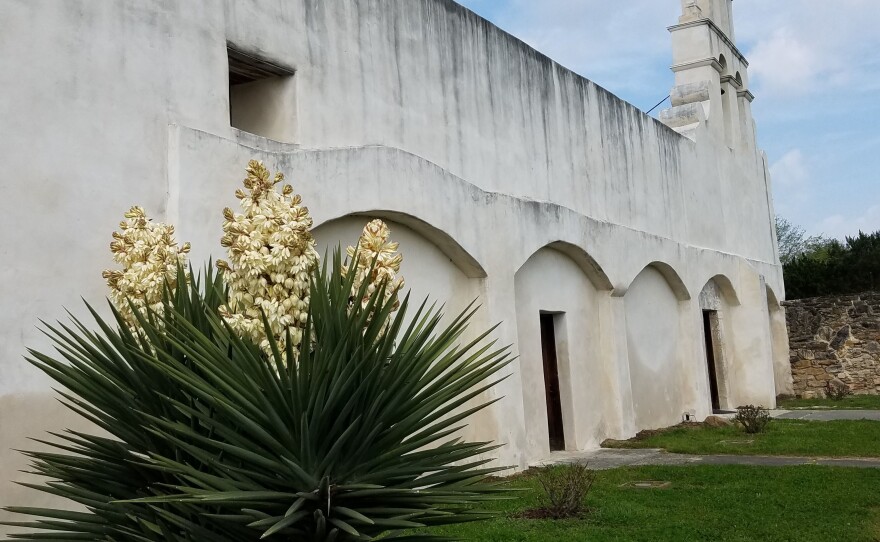On March 5, 1731, Spanish friars essentially handed the keys to San Antonio’s missions to the Native American families who lived there. Just four days later, 56 residents from the Spanish archipelago of the Canary Islands landed in San Antonio, sent by Spain’s King Felipe the Fifth to establish the first official government in the province of Texas. And with that, thousands of years of Native American history in San Antonio began to disappear.
It was called the Acto de Posesión. The Act of Possession. It was a key moment in San Antonio’s history. Three of San Antonio missions — Espada, Concepción, and San Juan Capistrano — would be owned by the native populations who lived, loved, worked, and died on the land.
It’s a piece of history American Indians in San Antonio are trying to recover.
Though the city celebrated its tricentennial in 2018, thousands of years of history existed before Spanish soldiers and friars stepped foot in Yanaguana — the Land of Spirit Waters, as San Antonio was known to the natives.
On March 9, the Mission San Juan commemorated the Acto de Posesión with a Founder’s Day celebration, featuring cultural entertainment, traditional foods, and native vendors. But the event was more than just a commemoration. It was an effort to re-write a narrative.

The event was hosted by American Indians in Texas at the Spanish Colonial Missions (AIT). Karla Aguilar, the group’s development coordinator, said Native Americans have been living in the region for millennia. “San Antonio grew around these Indian pueblos which were the missions,” said Aguilar. “These Indian pueblos were comprised of nomadic tribes that had been in the region for 10,000 years.”
Aguilar, who’s also a member of the Auteca Paguame tribe of the Tāp Pīlam Coahiltecan nation, said generations of San Antonians have been shamed out of their heritage. “To this day, people would rather identify their ancestral lineage as Canary Islander rather than Native American because there’s this underlying prejudice against being Indian, or la indiada,” she said. “Everything’s been taught to us from a settler’s perspective.”
State Poet Laureate Carmen Tafolla embraces her mixed background — the mestizaje — which goes back centuries in San Antonio. “The intermingling of the races was very present in my family’s narrative of who we were and why we had the high Indian cheekbones, and why our families were — as my grandmother used to say it — como los frijoles pintos. Algunos güeros, algunos morenos, algunos con pecas. Like a bunch of pinto beans. Some of us were light, some of us were dark, and some of us had freckles.”

Tafolla said the Eurocentrism present in much of Texas and San Antonio history must be shaken off in view of a larger picture, as it is a place “seeped in history, where there are bodies in this ground that were buried a thousand years ago, and there are structures in this ground that are millennia old.”
Those bodies in the ground? At the Mission San Juan, there have been two reburials of human remains, which were unearthed during a 1967 utilities dig.
Ramón Juan Vasquez is AIT’s executive director. AIT was founded to recover those Native American remains, which had been scattered in laboratories across the U.S. It took over 30 years to get most of the remains back home. Vasquez thought the struggle to recover the remains ended in 1999, when they were reburied at Mission San Juan. But it wasn’t. “(L)ast year I had to travel to UC Davis pick up 26 human remains, bring them home, reunite them with the remains that are at the Center for Archaeological Research (at the University of Texas at San Antonio),” said Vasquez. “The Texas Archaeological Research laboratory (at the University of Texas at) Austin has 11 human remains that were taken from Mission San Juan in the 1930s. SMU sent three that they had in their closets.”

The reburials at Mission San Juan are just part of the battle to rewrite a narrative. Vasquez says a larger cemetery exists where over 2 million tourists tread each year - on the grounds of the Cradle of Texas Liberty, the Alamo. 1,377 people are buried there. Their identities are recorded in the Alamo Book of Burials, which covered the years 1703 to 1885.
Vasquez asserts there needs to be a concentrated effort to acknowledge the burial ground — the campo santo — at the Alamo. He suggested arguments against the recognition comes down to racism. “(T)he reason is, as ugly as it sounds, because it’s nothing but dead Mexicans and Indians buried there,” said Vasquez. “And if it was a Catholic cemetery of Irish and German Catholics, they would have protected that cemetery a long time ago. If they thought that Davy Crockett was buried there, there would have been a fence around it a long time ago. But because it’s nothing but dead Indians and Mexicans, what else can I say? I mean, prove me wrong.”
The San Antonio Missions Cemetery Association and the Tāp Pīlam Coahiltecan nation are asking the Texas Historical Commission to designate that portion of the Alamo as a historic Texas cemetery. But it’s not a designation the Alamo Trust, a nonprofit that manages the day-to-day operations at the Alamo, wants to recognize. In a letter to the Texas Historical Commission dated January 18th of this year, the organization’s CEO Doug McDonald, writes that in the group’s opinion, “...a ‘historic cemetery,’ as defined by Texas law, does not exist on Alamo property.”

Ultimately, Vasquez wants the story of San Antonio to expand beyond that of Spanish soldiers and friars and Canary Islanders, which he acknowledges are beautiful narratives. “But I still believe that our story as a Coahuiltecan people is the greatest American story when it comes to perseverance. We’re still here.”
Norma Martinez can be reached by email at norma@tpr.org and on Twitter @NormDog1












